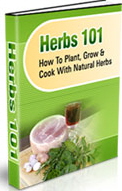Thyme
 Thyme is an easy to grow and hardy herb from the mint family. This versatile herb is a great addition for any home gardener.
Thyme is an easy to grow and hardy herb from the mint family. This versatile herb is a great addition for any home gardener.
Thyme has a lemon-mint flavor that is used in a variety of dishes. For culinary use the best varieties of Thyme are French, Lemon, English, and Winter. Most commonly, Thyme is used to flavor meats, fish, soups, and vegetables.
This herb is also rich in antioxidants and is a very health addition to anyone’s diet. Thyme contains a variety of important flavonoids and volatile oils, including thymol. Thymol is an essential oil that is a powerful antiseptic and antibacterial agent. Thyme is a very good source of many vitamins and minerals including vitamin K, calcium, and iron.
Growing thyme
Time may be started indoors from seeds 6 to 8 weeks before you plan to transplant outside, generally around March. Place the seeds in a pot with well-draining soil. Once planted, place the pot in a warm location of at least 60 degrees F. It can take anywhere from one week to three months for seeds to germinate.
Thyme prefers to grow in full sunlight, so choose an area that the sun will not be obstructed. Thyme plants will grow well in pretty much any soil, so not much preparation work is required. Simply till an area and transplant the plants. If you have poor-draining soil, you should mix in a little sand to improve the draining. Thyme plants need 12 to 16 inches of space in between the plants, so make sure to provide adequate room when planting in a garden.
The plants should be watered regularly, but avoid saturating the ground completely. Thyme prefers a somewhat dry soil, so the water should be able to drain completely.
Thyme should grow well without feeding or using and artificial fertilizers.
Harvesting Thyme
If planted in early spring, Thyme plants will be ready to harvest by mid-summer. Simply clip off a few stems before the pant begins to flower. Like most herbs, the flavor of the leaves will dissipate if the plant is allowed to flower.
Make sure to leave plenty of the plant left behind if you plan on continuing to grow the herb. Do not take more than 40% of the plant when harvesting. If this is the first year for the plant, take less leaves to encourage growth. Remove less than 30% of the leaves.
Thyme may also be dried for later use. If you plan on drying, snip larger branch sections and hang tem upside down in a well ventilated area.
For some great thyme recipes click here.

